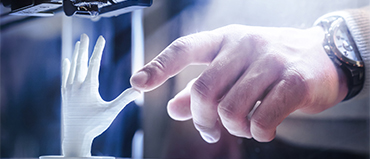3D printing, also known as additive manufacturing, has revolutionized the way we design, produce, and utilize objects. By creating three-dimensional objects from digital models, this technology has opened new avenues in various fields, from manufacturing to healthcare. This article delves into the different types of 3D printing, its diverse applications, the benefits it offers, and current industry trends.

Types of 3D Printing
There are several types of 3D printing technologies, each with unique processes and applications. Here are some of the most prominent:
- Fused Deposition Modeling (FDM): The most common and accessible form of 3D printing, FDM works by extruding melted thermoplastic filament through a heated nozzle, layer by layer. It’s widely used for prototyping, educational purposes, and hobbyist projects due to its cost-effectiveness and simplicity.
- Stereolithography (SLA): SLA uses a laser to cure liquid resin into hardened plastic, layer by layer. This technology is known for its high precision and ability to produce smooth, detailed objects, making it ideal for jewelry, dental models, and other applications requiring fine detail.
- Selective Laser Sintering (SLS): SLS employs a laser to sinter powdered material, typically nylon, into solid structures. It’s well-suited for producing durable and functional parts with complex geometries, often used in aerospace, automotive, and industrial applications.
- Digital Light Processing (DLP): Similar to SLA, DLP uses a digital light projector screen to flash a single image of each layer across the entire resin vat, curing the resin simultaneously. This method allows for faster printing times and is used for high-detail applications like dental and jewelry manufacturing.
- Multi Jet Fusion (MJF): Developed by HP, MJF uses an inkjet array to apply fusing agents to a bed of powder material, which is then fused by heating elements. This technology excels in producing highly detailed, strong, and functional parts, suitable for both prototyping and end-use products.
- Binder Jetting: In this process, a binding agent is selectively deposited onto a powder bed, layer by layer, to form an object. After printing, the object is typically cured and then infused with metal or other materials to enhance its properties. It’s widely used for producing metal parts, sand casting molds, and full-color prototypes.
Uses of 3D Printing
3D printing’s versatility has led to its adoption across various industries. Here are some notable applications:
- Prototyping and Product Development: 3D printing allows for rapid prototyping, enabling designers and engineers to quickly create and test prototypes before moving to mass production. This accelerates the product development cycle and reduces costs.
- Healthcare: In medicine, 3D printing is used to create custom prosthetics, implants, and even bioprinted tissues and organs. It allows for patient-specific solutions and advancements in regenerative medicine.
- Aerospace and Automotive: These industries use 3D printing to produce lightweight, complex components that are difficult or impossible to make with traditional manufacturing methods. This leads to more efficient, fuel-saving designs.
- Education and Research: 3D printers are valuable tools in educational settings, providing hands-on learning opportunities in engineering, design, and science. Researchers also use 3D printing to develop and test new materials and technologies.
- Consumer Goods: Customized products, such as footwear, eyewear, and jewelry, benefit from 3D printing’s ability to create personalized designs and short production runs.
- Construction: Large-scale 3D printing is being used to construct buildings and infrastructure, offering a faster and more sustainable approach to construction by reducing waste and labor costs.
Benefits and Advantages of 3D Printing
The advantages of 3D printing are numerous, making it an attractive technology for many applications:
- Customization: 3D printing allows for the creation of custom, one-of-a-kind products tailored to individual needs, without the need for expensive molds or tooling.
- Speed: Prototypes and parts can be produced much faster than with traditional manufacturing methods, significantly shortening development and production cycles.
- Cost-Effectiveness: For low-volume production and prototyping, 3D printing is more economical than traditional manufacturing, as it reduces material waste and eliminates the need for tooling.
- Complexity and Precision: 3D printing can produce intricate geometries and complex designs that would be challenging or impossible with traditional methods. This is particularly beneficial for industries requiring high precision.
- Sustainability: By minimizing waste and enabling localized production, 3D printing supports more sustainable manufacturing practices, reducing the environmental footprint of production processes.
3D Printing Industry Trends
The 3D printing industry is continually evolving, with several key trends shaping its future:
- Material Innovations: Advancements in materials science are expanding the range of printable materials, including metals, ceramics, composites, and bio-materials. This broadens the scope of applications and improves the functionality of printed objects.
- Increased Adoption in Manufacturing: More industries are integrating 3D printing into their production processes, not just for prototyping but also for end-use parts. This trend is driven by improvements in printer capabilities, material properties, and cost efficiencies.
- Automation and Integration: The integration of 3D printing with other technologies, such as AI, robotics, and IoT, is leading to more automated and streamlined production systems. This enhances efficiency and reduces human error.
- Bioprinting and Healthcare Advances: Bioprinting is making significant strides, with ongoing research aimed at printing functional tissues and organs. This has the potential to revolutionize medicine and address critical shortages in organ transplants.
- Sustainability Focus: The industry is increasingly focusing on sustainable practices, such as using recycled materials and developing eco-friendly printing processes. This aligns with global efforts to reduce environmental impact.
- Mass Customization: As consumer demand for personalized products grows, 3D printing is enabling mass customization, allowing businesses to offer bespoke products at scale.
3D printing is a transformative technology with a wide range of applications and benefits. Its ongoing advancements and integration into various industries promise to reshape manufacturing, healthcare, and many other fields, making it a pivotal technology for the future.
